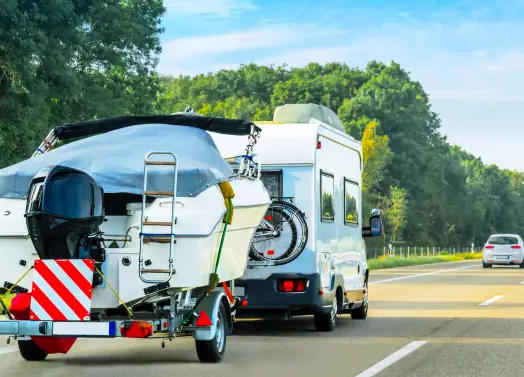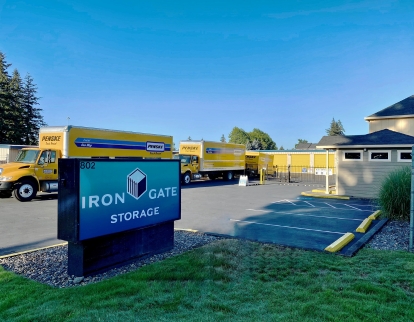

RV Storage and Boat Storage at Iron Gate Storage
Finding the perfect storage solution for your recreational vehicle (RV) or boat is crucial for maintaining its condition and ensuring it’s ready for your next adventure. Whether you’re looking to protect your investment during the off-season or simply need a place to keep it when not in use, our comprehensive RV and boat storage services offer peace of mind and security.
Types of RV and Boat Storage Options
Indoor Storage: A Premier Choice for RV and Boat Protection
- Comprehensive Protection: Indoor (enclosed) storage offers unparalleled protection against weather elements, including rain, snow, UV rays, and extreme temperatures. This enclosed environment helps preserve your vehicle’s exterior and interior, preventing long-term damage and maintaining its value.
- Enhanced Security: Indoor RV storage boasts superior security features, including 24/7 surveillance, alarm systems, and controlled access. This heightened level of security provides peace of mind, knowing your investment is well-protected against theft and vandalism.
- Preservation of Vehicle Condition: By storing your RV or boat indoors, you minimize the risk of environmental wear and tear, including rust, paint fading, and rubber seal deterioration. This preservation of condition can lead to lower maintenance costs over time.
- Space and Organization: Unlike outdoor or covered storage options, indoor units can offer more space for your RV or boat, along with room for accessories, making it a one-stop solution for all your storage needs. This organized approach can save you time and hassle when preparing for your next adventure.
Uncovered Storage: The Practical and Economical Choice
- Affordability: Uncovered storage represents the most cost-effective option for RV and boat owners. Without the additional costs associated with roofing or walls, it offers a budget-friendly solution for long-term storage, making it an attractive option for owners prioritizing affordability.
- Ease of Access: One of the primary advantages of uncovered storage is the ease of access it provides. Owners can quickly and efficiently park or retrieve their vehicles without navigating through enclosed spaces. This straightforward access is particularly beneficial for owners who frequently use their RVs or boats and require convenient entry.
- Flexibility in Space: Uncovered storage areas typically offer more generous space, accommodating vehicles of all sizes, from smaller boats and RVs to larger models that may not fit in standard indoor or covered units. This flexibility ensures that even the largest vehicles have a suitable storage option.
- Ventilation: Vehicles stored in an open environment benefit from natural ventilation, reducing the risk of mold and mildew buildup that can occur in more enclosed spaces. This natural airflow helps maintain the interior condition of the vehicle over time.
Simple Setup: Opting for uncovered storage often involves a simpler setup process. Owners can park their vehicles without the need for complex preparations required for indoor or climate-controlled environments. This simplicity is appealing for owners looking for straightforward storage solutions. - Ideal for Short-Term Storage: For owners who intend to store their RVs or boats for shorter periods, uncovered storage offers a practical solution. It provides sufficient protection against the elements for brief storage needs, making it an ideal choice for seasonal users or those awaiting more permanent storage arrangements.
- Protection Options: While uncovered storage exposes vehicles to the elements, owners can enhance protection with high-quality covers and other protective gear. This allows for a customized level of care tailored to each owner’s preferences and the specific needs of their vehicles.
Preparation for Storage
Before storing your RV or boat, dedicating time to thorough cleaning and maintenance not only preserves its condition but also prevents potential issues upon retrieval. Here are key steps and additional tips to ensure your vehicle is well-prepared for storage:
- Deep Cleaning: Start with a deep clean of both the interior and exterior. Washing the exterior can prevent rust and decay, while vacuuming and wiping down the interior can keep mold and mildews at bay. Don’t forget to clean the vents and undercarriage, which are often overlooked areas where dirt and moisture can accumulate.
- Engine Maintenance: For boats, flush the engine with fresh water to remove any salt and debris. For RVs, changing the oil and checking the coolant levels can prevent engine damage. This step is crucial for the longevity of your vehicle’s engine and ensures it’s ready for use when you are.
- Battery Care: Disconnect batteries to prevent drainage over time. Store them in a cool, dry place to avoid discharge and extend their lifespan. For long-term storage, consider using a battery maintainer to keep them at optimal charge levels.
- Tire Care: Inflate tires to the recommended pressure to prevent flat spots from forming during storage. For added protection, consider placing your vehicle on jack stands to remove weight from the tires and suspension system.
- Covering and Protection: Even in covered or indoor storage, using a breathable cover for your RV or boat can offer additional protection against dust and scratches. Make sure the cover fits snugly and is designed for your specific type of vehicle.
- Ventilation: Leave vents slightly open in RVs to promote air circulation and prevent the buildup of musty odors. However, ensure that openings are covered with fine mesh to keep insects and rodents out.
- Moisture Control: Place moisture absorbers or dehumidifiers inside your vehicle to maintain a dry environment, reducing the risk of mold and mildew growth.
By following these detailed cleaning and maintenance tips, you ensure that your RV or boat remains in prime condition during storage, reducing the need for extensive preparations when it’s time to hit the road or water again.
Winterizing your RV or Boat
Winterizing your RV or boat is a critical step in ensuring your vehicle’s longevity and reliability, especially in colder climates where freezing temperatures can cause significant damage. Expanding upon the initial guidance:
- Draining Water Systems: It’s essential to thoroughly drain the water systems, including tanks, pipes, faucets, and pumps, to prevent freezing and cracking. This includes flushing out the water heater and applying non-toxic antifreeze to the plumbing system to protect it from freezing temperatures.
- Fuel System Care: Adding a fuel stabilizer to the gas tank and running the engine for a few minutes distributes the stabilizer through the system, preventing fuel degradation and protecting the engine during storage.
- Battery Maintenance: Remove batteries from your vehicle, fully charge them, and store them in a cool, dry place to prevent freezing and extend their lifespan. For boats, it’s also advisable to disconnect and remove any other power sources, including solar panels.
- Seal Inspection and Protection: Check all seals, windows, and doors for potential leaks. Apply lubricant to rubber seals to keep them from drying out and cracking in the cold. Covering vents and openings with breathable material can prevent pests from entering while allowing moisture to escape.
- Engine and System Antifreeze:For inboard engine boats, it’s crucial to add antifreeze to the engine and cooling systems. This step protects the engine from freezing damage and ensures that all components are safeguarded against the cold.
By following these detailed winterizing steps, you ensure that your RV or boat remains in excellent condition, ready for use as soon as warmer weather returns. Our staff is equipped to guide you through each of these processes, offering advice and services to make winterizing your vehicle as straightforward and effective as possible.
